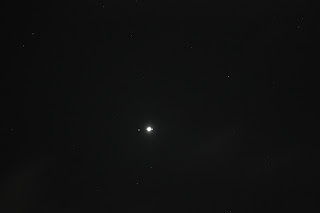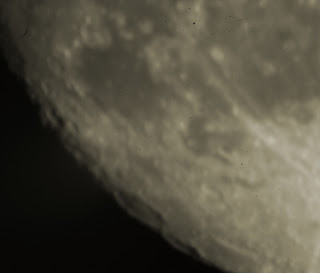October 25th 1000 GMT Partial Solar Eclipse
There was some clear sky before the eclipse started but it
did not clear again until it reached about mid-eclipse.
There was another clear spell later. I checked the Sun again
with my DSLR at 1025 GMT and the lunar disc had retreated.
October 21st 0550 GMT Moon
I snapped the Moon in the dawn sky with my DSLR at 300mm
focal length, ISO 100 and 1/200 second exposure.
October 20th 1830 GMT Meteor Hunt
October 17th 1830 GMT Meteor Hunt
It was dark already and lots of stars were out. I aimed my
camera at Perseus, with the Taurid, Aurigid and Orionid showers all active,
with the Orionid meteors possibly coming from below the horizon.
I caught a bright meteor at 1841 GMT that was not from any shower.
At 1857 GMT, I caught a fainter meteor in the same part of sky.
At 2001 GMT, I caught a UFO. Significantly, the sky was so misty that the only other object visible was the bright star Capella.
At 2018 GMT, I caught another UFO.
October 17th 0510 GMT Moon
The last quarter moon was high in the south east in a hazy
sky. I photographed it with my DSLR at 300mm focal length, ISO 100 and 1/500
second exposure.
October 15th 2200 GMT Moons and Planets
The first set of photos was with my Maksutov and DSLR at 1,540mm focal length, ISO 100 and 1/100 second exposure.
I added a 3x Barlow lens to deliver an increased focal
length of 4,620mm focal length, ISO 100 and 1/8 second exposure, although I
decreased it to 1/15 second exposure for Jupiter.
October 14th 2010 GMT Meteor Hunt
I set the camera at my usual meteor settings and aimed it at
Perseus. There were Taurid meteors in the area plus a small chance of some
Orionids coming from the horizon.
At 2058 GMT, I caught a strange trail when the moonlight had drowned out all the stars, including Capella, Some of the dots could have been ad bright as magnitude -3.
At 2120 GMT, a less spectacular but no less interesting trail appeared.
At 2230 GMT, I caught something similar.
Just 4 minutes later, I saw an object that just MIGHT have been a very bright head-on meteor but I feel safer claiming it as unidentified.
October 13th 0610 GMT Moon
The waning gibbous moon was riding high in the south west in
a clear sky. I photographed it with my DSLR at 300mm focal length, ISO 100 and
1/500 second exposure.
October 10th 2045 GMT Moon
I did a quick shot of the Moon with my DSLR at 300mm focal
length, ISO 100 and 1/800 second exposure.
October 9th 0030 GMT Jupiter, Moon and Others
It had cleared a bit and Jupiter and the Moon were in
east-west orientation. I started with a widefield shot of both at 300mm focal
length, ISO 100 and 1/40 second exposure.
I then tried the Moon with my Mak and DSLR at 1.54m focal
length, ISO 100 and 1/500 second exposure.
I combined this with the photo of the Moon with Jupiter.
I tried a similar approach for Jupiter but increased the
exposure to 1/200 second exposure.
I attempted to capture its moons at 1/3 second exposure.
I tried an audacious attempt at Mars, which was too far away
to try it by setting the exposure to 1/100 second exposure. No, it didn't work!
Betelguese was, again, about magnitude 0.4.
October 8th 2105 GMT Moon and Jupiter
The Moon and Jupiter were even closer in the sky than the
evening before but, unfortunately, there was a lot of thin cloud around and not
much was visible. I took a series of shots with my DSLR at 300mm focal length
and ISO 100.
The full disc moon shots did not focus, so that was it.
October 8th 1025 GMT Sun
Being Saturday, with a clear sky, I photographed the Sun
with my Mak and DSLR at 1.54 metres focal length, ISO 100 and 1/500 second
exposure.
October 8th 0120 GMT Betelguese
I checked outside before going to bed. Mars was in Taurus
but I thought it better to wait until a moonless night before taking a shot.
With Orion clear of the horizon, Betelguese looked unusually bright. From
experience, being as brighter as Rigel was due to extinction, with Rigel being
nearer the horizon. On the other hand, it was far brighter than Aldebaran,
which was a lot higher. Checking also against Pollux, I came to an estimate of
magnitude 0.4.
October 7th 2110 GMT Moon and Jupiter
I started off taking a shot of the Moon with Jupiter at 70mm
focal length, ISO 100 and 1/50 second exposure.
I followed up with a full disc lunar shoot with my Mak and
DSLR at 1.54m focal length, ISO 100 and 1/200 seconds exposure. The first image was inspired by the "mineral moon" photo and I boosted the saturation a few times.
I did a more traditional process.
I switched to Jupiter at 1.54m focal length, ISO 6400 and 1/3 second exposure to capture the moons. The Jupiter shot was underwhelming, with only a hint of the cloud belts.
I zoomed in, using a 3x Barlow lens to 4,62m focal length,
ISO 100 and 1/200 second exposure to try and capture planetary detail. I managed to underexpose Jupiter, which rather takes some doing. I combined the moons shot with the planetary disc.
I combined all the photos together.
I increased the exposure to 1/15 second to take some lunar close-ups.
With damp outside, I was not going to take my laptop
outside, so no webcamming for me!
October 6th 0655 GMT Sun
The Sun had cleared the houses just before it was time to
start work. Well, actually, I had already started work but 8AM is my official
start time, so I just stopped for a couple of minutes before my official start
time, as it was predicted to be cloudy at lunchtime. I did a quick shot with my
DSLR and filter. I used an exposure time of 1/1600 second exposure, as the Sun
was still quite low in the sky but, otherwise, used my normal settings. I could
see a large sunspot in my camera in my viewfinder, so I had a good chance of a
decent photo.
October 5th 2045 GMT Moon and Planets
At last, some clear night sky. It seemed like weeks since
the last one, but it wasn’t quite clear, with some cloud around. I started off
with the Moon, then Saturn and Jupiter, just in case I could get some detail. I
snapped Jupiter’s moons at the usual settings and the Moon with Saturn.
Jupiter and Saturn did not work but I got Jupiter's moons.
I combined the first and last shots to obtain a composite Moon with Saturn image.
October 2nd 1045 GMT Sun
“Confess!” said the Spanish Inquisition, so I did, indeed,
confess. I should have been getting on with the housework, as a good husband
should but I’m not always a good husband. The wet and cloudy early morning had
given way to bright sunlight. I had seen the Learmonth images and knew that new
activity had emerged onto the solar disc, having rotated from the far side. I also
knew that, whilst my filtered binoculars or DSLR, alone, would not do it
justice. Mrs Astronomer might forgive a quick bin scan but she doesn’t
read my blog.
So, yes, usual set-up. I stuck a filter on the finderscope
and could see sunspot activity immediately. Had I had more time, I would have
done a shot or few of the view through the finderscope. I took the usual shots
through the Mak with filter and DSLR at 1.54 metres focal length, ISO 100 and
1/500 second exposure.


























































































